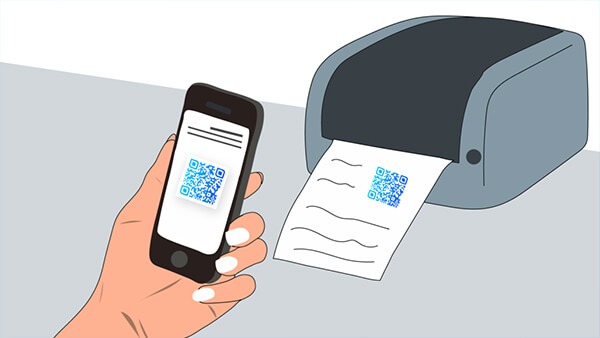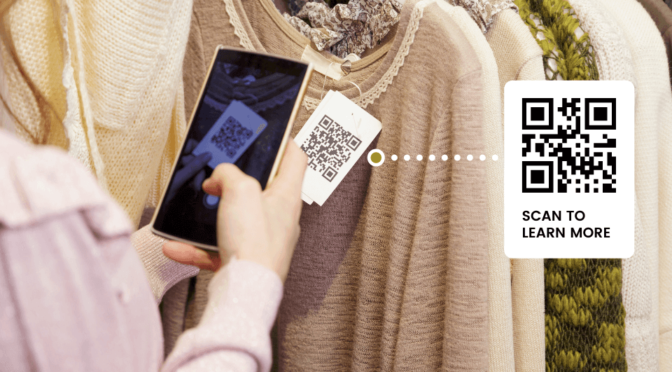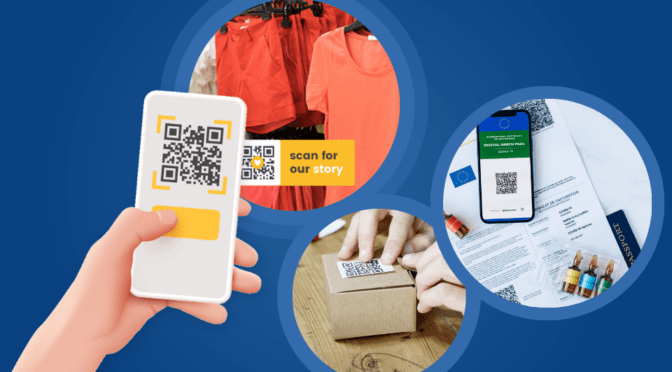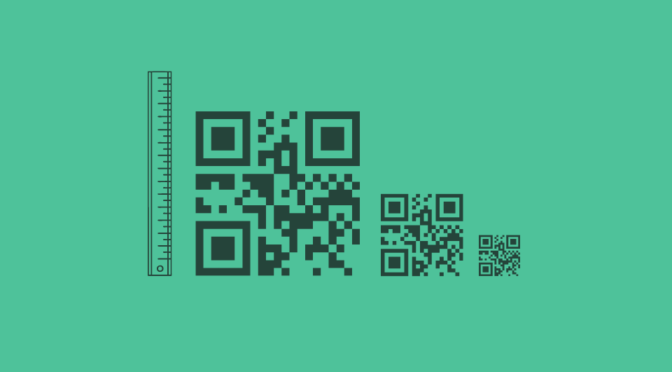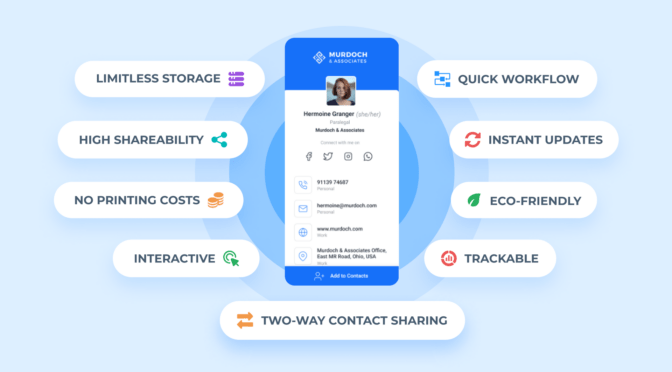💻 Key takeaways:
1. When printing high-quality QR Codes, some factors to keep in mind is the use of dynamic codes instead of static ones, optimal color, and contrast, logo placement for ease of scanning, use of negative space, type of surface, and size of QR Code.
2. Best practices for printing QR Codes include using high-resolution formats such as SVG and EPS, avoiding cluttering, placing the QR Code at eye level, adding a CTA, and testing a proof copy.
3. Industries such as food and beverage can use QR Codes on product labels to engage their customers and provide more information.
A Quick Response code or a QR Code is the next generation of a barcode. QR Codes are generally preferred over standard barcodes due to their ability to hold much larger data which includes URL links, geo coordinates, and text.
QR Codes have time and again proved instrumental in digitizing the physical spaces – be it a product, marketing collateral or a billboard.
Given its resurgence in the last couple of years, QR Codes are a favorite among marketers. However, some QR Code campaigns still witness limited success. This could be a result of multiple factors including not following QR Code printing guidelines.
In this blog post, I am going to walk you through the best practices for designing and printing QR Codes. I will also share examples of brands doing it right.

Table of Contents
3. Printing materials suited for QR Code
6. 5 steps for QR Code printing
7. Use of QR Codes on product labels
Creating the right QR Code for high-quality printing
As you establish the need for using a printed QR Code for your current use case, you may want to know the important things to keep in mind while creating your custom QR Code for print.
URL Length
One of the most important things to keep in mind while creating a QR Code is the URL length. The rule of thumb is, the shorter, the better. The simple reason behind this is, with a long URL, the resulting QR Code will be cluttered and dense and would make the process of scanning the code slower and tedious.

Dynamic vs Static QR Code
A Dynamic QR Code ramps up the functionality of a QR Code and takes its utility to the next step. If you choose to create a dynamic QR Code, you can change the link behind the QR Code anytime, as per your need. You don’t have to replace the QR Code then.
This means that if you have a dynamic QR Code installed, you can carry out a full-fledged marketing campaign with it. You just need to change the action that the code triggers as per your needs, and get the necessary insights and analyses from it.
Another feature that gives dynamic codes an edge over its static counterpart is that with the former, you can avoid a cluttered code even with a long URL. It reduces the scanning time, without disturbing the purpose. Dynamic QR Codes in a way is a workaround for longer URL QR Codes.
Check out this complete guide on dynamic vs. static QR Codes.
Designing QR Codes that can be successfully scanned
A simple black and white QR Code with no context whatsoever is less likely to serve its purpose than a customized, well-designed one. This is why it is necessary to work on the design and aesthetic appeal of the QR Code. There is a lot more than the color of the QR Code that can help the case –
Color & Contrast
A custom QR Code generator allows you the flexibility of changing the color of the QR Code. The best use of the same is to match the QR Code’s color with any specific color scheme of the background or even your brand’s identity or logo. This will serve a two-fold purpose. Firstly, creating brand recall with the QR Code and secondly, providing a credence quality to the code.
The contrast between the QR Code and its background should be sufficient to ensure easy scanning. High contrast, such as black QR Codes on a white background, is typically recommended for best results.
Logo
A customizable QR Code allows you to place your logo in the middle of the QR Code and give an identity to your QR Code. If you don’t have a logo, being a small business or freelancer, you can leverage AI to create a logo or use an online logo maker to give your QR Code a visual that’s more in tune with your brand. One important thing to keep in mind is that the logo should not be a large one, as it would halt its scanning. It is even possible to add the logo of the brand in the background of the QR Code with Uniqode’s QR Code generator.

Negative space
It is a general practice to leave some space around your QR Code, along its boundary. 4 blocks of space are considered ideal so that the QR Code scanner can scan the QR Code without much effort.
Make sure when you’re designing the QR Code, or printing it on your collateral, this breathing space is not disturbed by the other elements like images, copy or frame. It is very important to not tinker with the three squares on the edges of the QR Code for the work seamlessly.

Printing materials suited for the QR Code
The material on which the QR Code is printed is an important consideration. In fact, it is as important as the content and design of the QR Code. Choosing the right material depends on the purpose of the QR Code.
The choice of printing material can impact the durability and readability of QR Codes. Materials should be durable enough to withstand handling and environmental conditions while maintaining print quality.
Printing technique
Various printing techniques, such as digital, offset, or screen printing, can be used to print QR Codes. The printing technique should be selected based on factors such as volume, budget, and desired print quality.
Ink and toner quality
High-quality ink or toner should be used to ensure sharp, clear printing of QR Codes. Poor-quality ink or toner can result in smudging or blurring, reducing the readability of the QR Codes.
Smoothness or shine of the surface
One important thing to factor while printing the QR Code is the glossiness of the material on which the QR Code is printed. If the material is reflective, it would make scanning the QR Code difficult as it would be very shiny and compete with the scannability of the QR Code.
Type of surface
If the surface of the material is rugged or rough, it can distort the QR Code, reducing the scannability and durability of the QR Code. On such surfaces, if your QR Code is busier and more cluttered than usual, it will delay the process of scanning and could go unused as well.
This is why you have to be a good judge of the place where you are going to print the QR Code. For instance, you can create a QR Code for a magazine, but printing it between the magazine’s fold could distort the barcode image and defeat the purpose of placing QR Code there.

Size of the QR Code for printing – How small can a QR Code be?
There is no universal size of the QR Code used on products. However, they should be printed at an appropriate size to ensure readability by scanning devices. The QR Code print size depends upon the printing material or the merchandise used.
The size should not be too small, making it difficult for scanners to capture, nor too large, wasting space on printed materials.
Generally, if the code is to be used in a small to a medium-sized product, (e.g. flyers or business cards), the size of the QR Code should be at least 0.4 inch x 0.4 inch (1 cm x 1 cm).
The minimum size of a QR Code should be,
Size of the QR Code = Distance/10
NOTE: The symbol size of any logo used on the QR Code must be 21 x 21 – 177 x 177 modules (size grows by 4 modules/side) and the structured appending must be a maximum of 16 symbols (printed in a narrow area).
Distance between the QR Code and the device
One should also consider the distance between the QR Code and the user’s smartphone. It directly impacts the scan time. Scanning a QR Code takes less than a couple of seconds and anything more than that would lead to a decrease in the total number of scans.
The Ideal ratio between the size of a QR Code and distance of scanning device
For QR Codes on mediums that are afar, smartphones follow a 10:1 ratio between the distance of the QR Code from the device and the size of the QR Code (in inches).
So, for instance, if the distance between the QR Code and the device is 100 inches, the smallest size of the QR Code must be 10 inches. This can be used as a rule of thumb, although other factors like the lighting have an important role to play.
For QR Codes on business cards, magazines, and pamphlets – QRs that are scanned from up close, the minimum size, generally is 0.4 inches excluding the margins (by ISO 18004-compliant QR Codes).
For more detailed info on QR Code size, check out our QR Code sizing guide.
Downloading the QR Code
A QR Code can be downloaded in many different formats, including .png, .jpeg and .eps. Each of these serves a different purpose and thus, this step is crucial.
Format of QR Code
If you are creating a QR Code for, say, a banner or a poster or a billboard, downloading the QR Code in a simple .png or .jpeg format would not work.
The simple reason behind this is, the QR Code will look blurred or distorted once increased in size. So, it is better to download the QR Code in a scalable format like .svg or .pdf or .eps. to avoid distortion.
How to print a QR Code? – 5 steps you must follow
1. Always use high-quality images
You need to make sure that the QR Code images are in higher resolution. It is because pixelated or blurry QR Codes, result in non-readability by the camera or app scanner, or delaying the time of scan which irritates the customer or the user.
Thus, using high-quality images not only looks professional but also it is a necessity in any case.

2. Placement of the code
If you did everything right yet did not place the QR Code in an ideal location for the customer or user, he or she may still not be able to access the code.
A QR Code should be placed at an eye level of the person such that it is easily noticeable. The placement of the code could differ in the case of receipts, posters, flyers, brochures, or billboards and banners or hybrid mail solutions like Docmail.
If the QR Code is a part of your out-of-home (OOH) advertising campaign, then placing it too high or too low on the advertisement can prevent the users from scanning the code. Similarly, the QR Code should be placed at a spot in your collateral where it can be easily seen and without any clutter.

3. Avoid multiple QR Codes in a single place
The multiplicity of QR Codes in one space can lead to the scanning of the wrong QR Code. Not only that, but it is also possible for a QR Code to intrude on the breathing space of another QR Code. Therefore, it is important to have a wide distance between two or more QR Codes.
If you still need to place two QR Codes in single collateral or paper, having each QR Code on each of the ends of the collateral or paper is a good practice for avoiding the possibility of the wrong scan. On the other hand, you can create a dynamic QR Code where you can store multiple information.

4. Add a small call to action along with the QR Code
As discussed earlier, having a small CTA along with the code works wonders in telling the person about the functionality of the code. It helps in building a quick trust and incite scan from the person if they are already thinking about the QR Code.
Even a simple “scan me” could compel someone to scan the QR Code which may result in increased engagement as compared to having a QR Code without any CTA.

5. Test the QR Code
Last but not the least, always test your QR Code after all the necessary steps were taken in its creation.
Once you test it with multiple devices with different operating systems and in multiple scenarios such as in broad daylight, or a little dark place, or inside a full bright room; you will come to know whether the QR Code is functional or not for your campaign. Also, don’t forget to get a proof copy first from your printer to test scan, before you start printing it in a large number.
Saves time saves money!

Use of QR Codes on product labels
Businesses use QR Codes on their product labels for multiple reasons – Firstly, to engage with customers, secondly, to provide information about the product or the company. Many brands are already killing it with their QR Code journey.
💡Fun Fact:
Over 90% of business leaders anticipate increased QR adoption across sectors.
Explore more fascinating insights in our State of QR Code Report!

Here is a list of industries printing QR Codes on their product labels for various purposes.
Food industry using QR Codes
The food companies are using QR Codes on their products to add more value to the offering. For example, if the food item is one element of a whole recipe, the code is used to provide suggestions on the rest of the items and how it could help in creating the whole meal. Tastemade through its “Good Food Book” provides 50 recipes with QR Codes associated with each of them. These QR Codes when scanned open videos showing how to prepare the particular recipe.
Beverage industry using QR Codes
Many juice and beverage companies already have QR Codes imprinted on their product labels having different purposes.
Some use it to provide detailed information about the product, some use it to inform consumers about their new beverages, some use it to engage consumers with various rewarding competitions and in return increase brand awareness and loyalty.
Horticulture Innovation Australia and Australian Authentic branded olive oil bottles with a QR Code. This QR Code provides detailed information about the origin of the olive and confirms its authenticity.
Wine and Beer industry using QR Codes
The wine and beer companies could use this opportunity to make every customer a wine connoisseur or cicerone. Generally, if you are purchasing wine for a special occasion and do not have much expertise in wine, you tend to ask your friends or Google it.
But if the wine bottle itself provides all the necessary information through the QR Code on its label, wouldn’t it be much easier for the customer to select the perfect wine for that perfect occasion?
It can also provide various wine mixing suggestions that could go with a particular wine. Also, it can provide the smallest detail such as what food goes well with the wine. For example, Australian manufacturer McGuigan uses QR Codes to suggest match-ups between wine bottles and specific foods.
So, are QR Codes worth all the effort?
QR Code is no new concept, and in all possibilities, it is here to stay. The multi-purpose nature of the QR Codes allows the brands to carry out a wide array of activities with them, and the use of Dynamic QR Codes can take the utility to a whole new level.
Explore our dynamic QR Code pricing plans to generate a QR Code for your business today. You can also start a 14-day free trial. If you need further assistance, talk to one of our experts today!
Ektha is a QR code expert with years of research and analysis into the evolution of QR codes. Having written over 70 in-depth articles on QR technology, she has developed a comprehensive understanding of how QR codes are transforming industries. Her insights, including The State of QR Report, have been featured in leading publications. With a passion for simplifying complex topics and providing actionable strategies, Ektha helps businesses leverage QR codes to enhance their ‘phygital’ connections.







